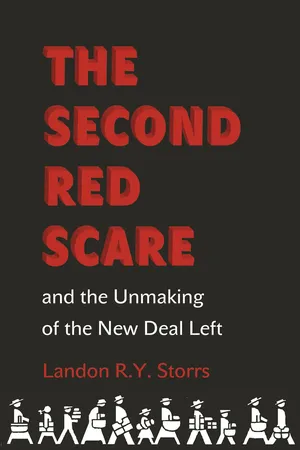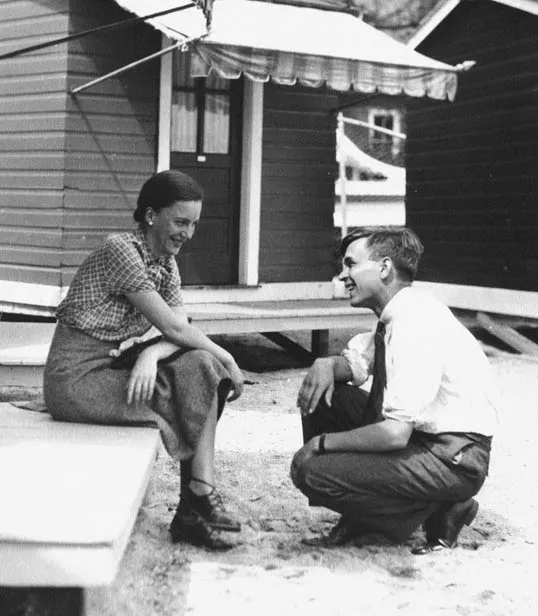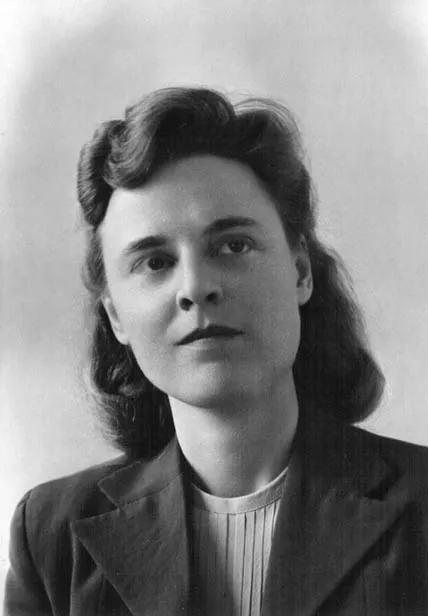![]()
Chapter 1
When the Old Left Was Young . . . and Went to Washington
In a famous description of the changes that Franklin Roosevelt’s New Deal wrought in the nation’s capital, one veteran civil servant grumbled that “a plague of young lawyers settled on Washington. They all claimed to be friends of somebody or other and mostly of Felix Frankfurter and Jerome Frank.” In another classic portrayal, the historian Arthur M. Schlesinger Jr. explained that the Great Depression, by reducing private employment options, “made men of intellectual ability available as never before; and the government had never been so eager to hire them. . . . With each prominent New Dealer acting as his own employment agency, Washington was deluged with an endless stream of bright young men.” Schlesinger described their ideological orientations as ranging from fiscal orthodoxy to Wilsonian liberalism to Theodore Rooseveltian progressivism. They were passionate about ideas and worked long hours, but that did not prevent them from drinking, dancing, and arguing much of the night, transforming stuffy, sleepy Washington into a lively, sophisticated city. “The memories would not soon fade—the interminable meetings, the litter of cigarette stubs . . . the call from the White House, the postponed dinner, the neglected wife, the office lights burning into the night, the lilacs hanging in fragrance above Georgetown gardens while men rebuilt the nation.”1
Schlesinger’s evocative portrait omitted a cohort of leftist women and men whose presence was crucial to Washington’s transformation and to the design and implementation of many hallmark New Deal policies. It is widely known that capitalism’s crisis shifted the American political spectrum to the left in the 1930s, and also that the decade’s protest movements included one comprising radical students on college campuses around the nation.2 Less recognized is the fact that after graduation many of those young radicals—economists, social workers, and yes, lawyers, foremost among them—took jobs in the federal government. The high unemployment rate did make government jobs more attractive to men, but the civil service was especially attractive to a growing pool of professional women, who had trouble obtaining corporate and academic positions regardless of the state of the economy.
The influx of leftists and women (not exclusive categories) into government made it easier for conservative critics of the New Deal to paint it “pink.” When Schlesinger published his paean in 1958, the postwar Red scare was dissipating but still emitting noxious fumes. It is not surprising that Schlesinger, a liberal activist as well as a historian, did not highlight the leftist or female presence in Washington’s corridors and lilac-scented gardens. Deliberate or not, Schlesinger’s omissions—compounded by the reticence of many former civil servants—contributed to misunderstandings that subsequent scholarship has not dispelled.3
“Hope That the Present Government Is Something More Than a Conscious Agent of Vested Interests”
Many of the young professionals who came to Washington had been deeply influenced by socialism, and their initial expectations of the Roosevelt administration were low. They were attracted more by the promise of a job than by the promise of a New Deal. However, in agencies such as the Federal Emergency Relief Administration, the Department of the Interior, the National Labor Relations Board, the Social Security Administration, the Works Progress Administration, and later the Office of Price Administration, these pragmatic leftists found unexpected opportunities to advance their convictions, as well as their careers. They came to believe that it might be possible in the United States to realize the social democratic vision of a mixed economy in which a vital public sector balanced the power of the private sector. In view of capitalism’s demonstrated, structural tendency to create an economically and educationally impoverished class, they argued that democracy could be sustained under capitalism only with government action to mitigate economic and social inequalities.
Arthur “Tex” Goldschmidt is a good example of a young radical who initially had little faith in the New Deal. In his eighties, he explained:
I call myself an early New Dealer because it seems so from this perspective. But you would be wrong to assume immediately that I was one of those idealistic young people who flocked to Washington in 1933 to help Roosevelt’s program save the country. It was not quite like that. Sure, I was young and idealistic. Sure, I went to Washington at the first job offer. But neither I nor anyone I knew had much confidence in the new administration or even thought it had a program.4
The son of freethinking German immigrants to San Antonio, Texas, Goldschmidt worked his way through Columbia University, where he studied economics and government with the left-leaning professors Rexford Tugwell and Joseph McGoldrick. As a founder of the Social Problems Club, which became the Columbia chapter of the National Student League, Goldschmidt helped organize some of the student movement’s formative events, including a pilgrimage in support of striking Kentucky coal miners in the spring of 1932, followed by a protest of Columbia’s expulsion of the student newspaper editor Reed Harris. Newspaper coverage of both events foregrounded Goldschmidt and his friends Rob Hall and Howard Westwood. Hall soon joined the Communist Party and left school to organize sharecroppers in his native Alabama.5 Goldschmidt and Westwood continued their studies and then took jobs in Washington—as did the young radicals they married.
During the fall of 1932, Goldschmidt fell in love with a woman who shared his disdain for Franklin Roosevelt’s campaign platform. Raised in a prosperous Ohio family, Elizabeth Wickenden had graduated in 1931 from Vassar College, where her professors included Caroline Ware, and where she wrote her senior essay on the “still taboo subject” of federal relief for unemployed workers. An aspiring writer, she then spent a year in Europe, including a month in the Soviet Union that produced a series of articles published by the Cleveland Plain Dealer. She decided to try her luck in New York City, where she rented a studio apartment on the top floor of a five-story walk-up on Twelfth Street. Unable to find paid employment, she volunteered at the Emergency Exchange Association, a nonprofit experiment in organizing the production of goods and services among the unemployed. One of her fellow volunteers was Tex Goldschmidt. They shared lunches at the local Automat, where they discussed the “need for more radical approaches” than anything they were hearing in the presidential campaign. Tex recalled that “as it became clear that Hoover would surely lose, most thoughtful people sought to express their dissatisfaction with the Tweedledum-Tweedledee likenesses of the two major parties and debated whether a vote for Norman Thomas or William Z. Foster would best serve to do so.” Goldschmidt did not record which way he and Wickenden voted. But he did note that she soon bought him “a toothbrush to hang alongside hers” in that Twelfth Street studio.6
Despite their agreement that Roosevelt’s victory was “politically meaningless” and that Washington was “a sluggish southern backwater,” when a friend from the Emergency Exchange Association offered Wickenden and Goldschmidt jobs in the new Federal Emergency Relief Administration, it was hard to say no. Freshly married and with “a nest egg of $125 to start out staring winter in the face,” they took the jobs, promising each other to stay no more than six months in Washington. They stayed for eighteen years—and departed then only because Goldschmidt’s move to the United Nations required them to live in New York. Between them, they became experts on public assistance, social insurance, public works, and public power, and they advised such prominent figures as Harry Hopkins, Harold Ickes, Wilbur Cohen, and Lyndon Johnson. They became Democratic Party members, but they never stopped trying to push that party to the left. Goldschmidt later claimed, “Neither my wife nor I were motivated by planned goals for ourselves but kept restlessly seeking ways to nudge for changes that might yield progress in the evolution of our society. My own work was rarely boring. My role was almost always a yeasty one—critical, doubtful, experimental; on the cutting edge—or the left fringe, if you prefer.”7
Meanwhile, Goldschmidt’s fellow Columbia radical Howard Westwood married Charlotte Tuttle, like Westwood a star at Columbia Law School (and also, it happened, Wickenden’s former classmate at Vassar). Westwood clerked for Supreme Court Justice Harlan Stone before going into private practice.8 Tuttle, the daughter of a U.S. Attorney and former Republican candidate for governor of New York, had drawn headlines at the age of nineteen by declaring herself a socialist after an undercover stint as a factory girl, and then by defending the rights of students arrested while trying to organize female garment workers.9 She became one of six women in the class of 1934 at Columbia Law School and one of two women who made the Columbia Law Review. Her father paid her tuition despite his certainty that no law firm would hire a woman. The federal government, however, proved eager to hire her. Even before she had passed the bar exam in 1934, Tuttle was recruited into the Interior Department solicitor’s office by Felix S. Cohen, who had known Tuttle through the socialist League for Industrial Democracy (LID) as well as at Columbia Law. Tuttle helped Cohen shape New Deal policy on Native American rights. She traveled to reservations to help tribes draft constitutions under the Indian Reorganization Act, and she contributed to Cohen’s classic Handbook of Federal Indian Law (1941). After Westwood divorced her in 1939, Tuttle married David Demarest Lloyd, a New Deal lawyer whose radical forebears included the muckraking journalist Henry Demarest Lloyd. From 1945 to 1948 she was assistant general counsel for the United Nations Relief and Rehabilitation Administration in Washington and London. When David Lloyd became an aide to President Truman in 1948, Charlotte suspended her career and focused on raising their two children. Later, Charlotte Tuttle Lloyd became the first woman assistant general counsel in the Treasury Department (1965–73).10
Young leftists joined the Roosevelt administration because it was the best employment available to them, not because they had much faith in its potential to fulfill their social justice ideals. Once on the job, their skepticism softened. Goldschmidt was impressed by Harry Hopkins’s penetrating critique of the existing relief system. Present at what he later called the Federal Emergency Relief Administration’s “Big Bang” in September 1933, Goldschmidt helped conceive and administer the Civil Works Administration, which created several million jobs during the harsh winter of 1933–34. After Wickenden wrote a perceptive report on the problem of transients—who did not meet states’ residency requirements for aid—she found herself in charge, at age twenty-five, of a pioneering federal relief program affecting about 350,000 people around the country.11 By 1938 she had concluded that “democracy can be made to work within the framework of modern capitalist organization”—if, through “public taxing and regulatory power,” democratic government could “reconcile conflicting economic interests in order that all people may have reasonable security, an adequate standard of living, and an opportunity to participate in the solution of common problems through political or other action.” She spent the rest of her career trying to change that if to when.12
Figure 1.1. Elizabeth Wickenden and Tex Goldschmidt, Lake George, N.Y., July 1933. Wickenden kept this photo, taken shortly after they married, on her desk for many decades. Courtesy of Ann Goldschmidt Richardson and Arthur Goldschmidt Jr.
Felix Cohen was another person who found himself unexpectedly impressed by the possibilities under the Roosevelt administration. After a few weeks as assistant solicitor in the Interior Department, Cohen wrote to his mentor, the Socialist Party leader Norman Thomas, that his early impressions supported “the hope that the present government is something more than a conscious agent of vested interests, and that a political seizure of power by a party that appeals to the masses will not face the threat of sabotage from within the civil service, though it will undoubtedly face that threat from Big Business.”13 The son of the distinguished philosopher Morris Raphael Cohen was named after Felix Frankfurter, and he excelled in both those men’s fields, earning a Ph.D. in philosophy at Harvard in 1929 and a law degree from Columbia in 1931. As an undergraduate at the City College of New York, he had been active in the Socialist Party and the League for Industrial Democracy well before the Depression swelled their ranks. In 1925 Felix used his position as editor of the campus newspaper to protest mandatory military training in the form of Reserve Officers’ Training Corps courses. The college administration prohibited the newspaper from discussing the topic further, and the ensuing battle mobilized pacifists and civil libertarians across the nation. It also resulted in Felix’s temporary exclusion from City College’s Phi Beta Kappa chapter.14 The experience only deepened Cohen’s convictions. On a date in 1927 with his future wife, the anthropologist Lucy Kramer, they attended an execution-day vigil for the anarchists Sacco and Vanzetti in Union Square, where Felix shared the platform with Norman Thomas.15
Figure 1.2. As a lawyer in the Interior Department, Charlotte Tuttle Westwood helped administer the Indian Reorganization Act of 1934. In 1940 she married David Demarest Lloyd, whom she met at a hearing on the exploitation of migrant agricultural workers. Courtesy of Louisa Lloyd Hurley.
Despite Cohen’s radical commitments, when the new Interior Department Solicitor Nathan Margold offered Felix a job in 1933, he quickly accepted.16 Describing to Norman Thomas “the position that one Socialist finds himself in within the framework of a capitalist government,” he explained that he had “no illusions about the efficacy of boring from within” but would have “a good deal of leeway” in his new job. Cohen reminded Thomas that, during a 1926 LID conference, Thomas had advised young Socialists to avoid getting married or having children and to get “strategic positions in civil service.” Married but childless when the government hired him, Cohen joked that “67% would be a passing mark.”17 Thomas reassured Cohen that he did not blame him for taking the job: “You are young and as yet your name does not imply Socialist approval of the administration. . . . We simply must have workers so trained if we are to build successfully in the future.”18 Cohen soon discovered that both Margold and Interior Secretary Harold Ickes were serious about the rights of minorities, whether Native Americans or African Americans or Jews.19 Cohen stayed at Interior until 1947, acquiring a reputation as a passionate advocate for Native Americans—and also as someone who hired smart women like Charlotte Tuttle.20
A New Deal for Women
Tuttle was ...


